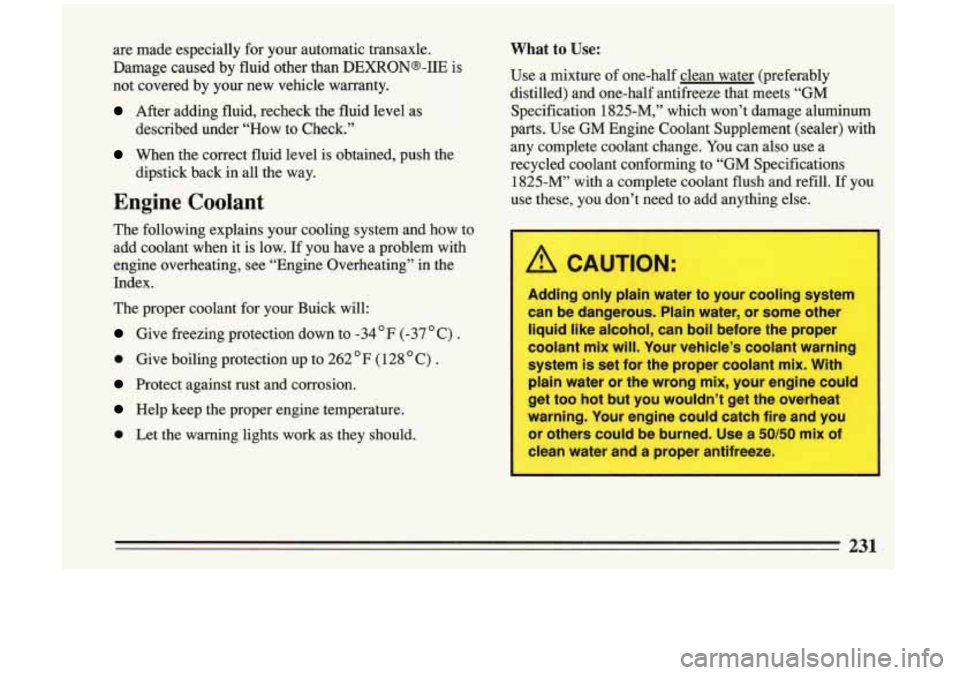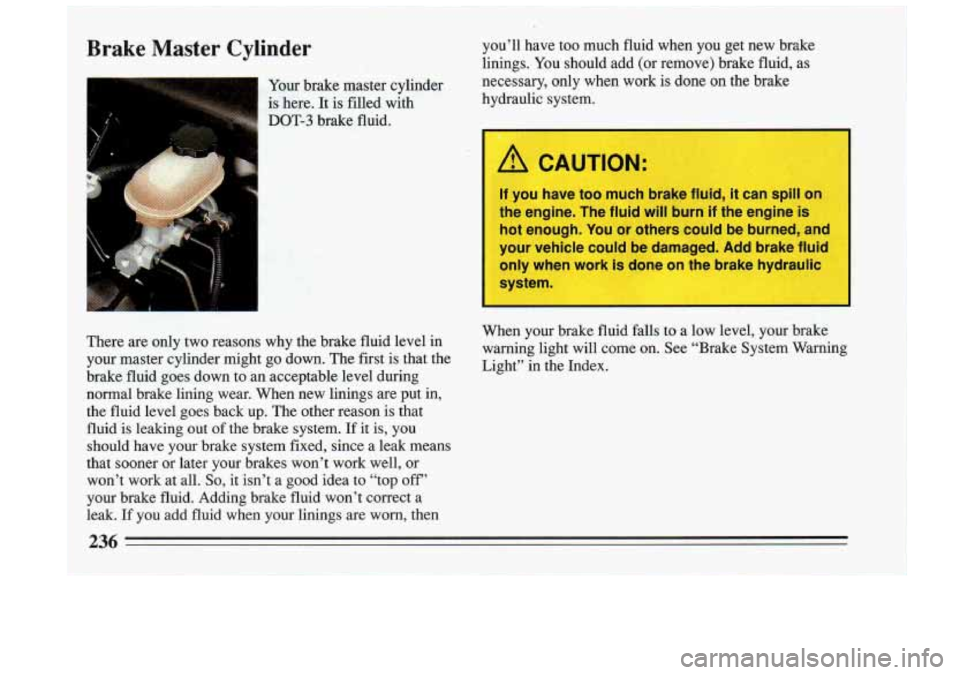Page 230 of 324
Air Cleaner
As you face the front of the vehicle, the air cleaner is in
the front right section of the engine compartment. There
is a filter inside the air cleaner.
Refer to -the Maintenance Schedule
to detemine when
to replace the air filter.
A I
A CAUTION:
Operating the engine with the air cleaner off can
cause you or others
to be burned. The air
cleaner not only cleans the air,
it stops flame if
I the engine backfires. If it isn’t there, and the
engine backfires, you could be burned. Don’t
drive with
it off, and be careful working on the
engine with the air cleaner off.
I
the air cleaner is off, a backfire can cause a
See “Scheduled Maintenance Services” in the Index.
228
Page 231 of 324
Automatic Transaxle Fluid
When to Check and Change:
A good time to check your automatic transaxle fluid
level is when the engine oil is changed. Refer to the
Maintenance Schedule to determine when
to change
your fluid. See “Scheduled Maintenance Services” in
the Index.
How to Check:
Because this operation can be a little difficult, you may
choose to have this done at a Buick dealership Service
Department.
If you do it yourself, be sure to follow all the
instructions here, or you could get a false reading on the
dipstick.
Page 232 of 324
Then, without shutting off the engine, follow these
stem:
1. Pull out the dipstick and
wipe it with a clean rag
or paper towel.
2. Push it ‘back in aa the way, wait three seconds and
I :then pull it back out again.
3. Check both sides ofthe
dipstick, and read the
lower level. The fluid
level must be
.in the
cross-hatched
mea.
P
4. If the fluid level is where it should be, push the
How to Add Fluid:
dipstick back in all the way.
Refer
to the Maintenance Schedule to determine what
kind of transaxle fluid to
use. See “Recommended
Fluids and Lubricants” in the Index.
If the- fluid level is low, add only enough of the proper
fluid
to bring the level into the cross-hatched area on the
dipstick. It doesn’t take much fluid, generally less than a \
pint. D,on’t overfill. We recommend you use only fluid
labeled DEXRONB-IIE, because fluids with that label
230
I
Page 233 of 324

are made especially for your automatic transaxle.
Damage caused by fluid other than
DEXRONs-IIE is
not covered by your new vehicle warranty.
After adding fluid, recheck the fluid level as
described under
“How to Check.”
When the correct fluid level is obtained, push the
dipstick back in all the way.
Engine Coolant
The following explains your cooling system and how to
add coolant when it is low. If you have a problem with
engine overheating, see “Engine Overheating” in the
Index.
The proper coolant for your Buick
will:
Give freezing protection down to -34’F (-37 ’ C) .
0 Give boiling protection up to 262 ’ F ( 128 ’ C) .
Protect against rust and corrosion.
Help keep the proper engine temperature.
0 Let the warning lights work as they should.
What to Use:
Use a mixture of one-half clean water (preferably
distilled) and one-half antifreeze that meets “GM Specification 1825-M,” which won’t damage aluminum
parts. Use GM Engine Coolant Supplement (sealer) with
any complete coolant change. You can also use a
recycled coolant conforming to “GM Specifications
1825-M” with a complete coolant flush and-refill.
If you
use these, you don’t need to add anything else.
Adding only plain water to your cooling system
can be dangerous. Plain water, or some other
liquid like alcohol, can boil before the proper
coolant mix will. Your vehicle’s coolant warnin!
system
is set for the proper coolant mix. With
plain water or the wrong mix, your engine coul
get
too hot but you wouldn’t get the overheat
warning. Your engine could catch fire and you
or others could be burned. Use a
50150 mix of
clean water and
a proper antifreeze.
231
Page 234 of 324
Adding Coolant
The engine coolant
recovery tank is located at
the left
of the engine
compartment.
To Check Coolant: When
your engine is cold, the
coolant level should be at
“FULL COLD,” or a little
higher. When your engine
is
warm, the level should be
up to
“FULL HOT,” or a
little higher.
To Add Coolant: If you need more coolant, add the
proper mix at the coolant recovery
tank.
232
Page 235 of 324
A CAUTION:
Turning the radiator pressure cap when the
engine and radiator are hot can
allow steam and
scalding liquids to blow out and burn you badly.
With the coolant recovery tank, you
will almost
never have to add coolant at the radiator. Never
turn the radiator pressure cap
-- even a little --
when the engine and radiator are hot.
Add coolant mix at the recovery tank, but be careful not
to spill it.
A CAUTION:
You can be burned if you spill coolant on hot
engine parts. Coolant contains ethylene glycol,
and it
will burn if the engine parts are hot
enough. Don’t spill coolant on a hot engine.
Radiator Pressure Cap
When you replace your radiator pressure cap, an ACS
cap
is recommended.
Thermostat
Engine coolant temperature is controlled by a thermostat
in the engine coolant system. The thermostat stops ,the
flow of coolant through the radiator until the coolant
reaches a preset temperature.
When you replace your thermostat, an AC@ thermostat
is recommended. I
233
Page 236 of 324
i Power Steering Fluid I
What to Add:
Refer to the Maintenance Schedule to determine what
kind
of fluid to use. See “Recommended Fluids and
Lubricants”
in the Index.
I
i
How To Check Power Steering Fluid:
~ Unscrew the cap and wipe the dipstick with a clean rag.
: Replace the cap and completely tighten it. Then remove
~ the cap again and look at the fluid level on the dipstick.
When the engine compartment is hot, the level
When the engine compartment is cool, the level should be
at
the “HOT” mark.
should be at the
“FULL COLD” mark.
I
Page 238 of 324

Brake Master Cylinder you’ll have too much fluid when you get new brake
linines. You should add (or remove) brake fluid, as
U
your brake master cylinder necessary, only when work is done on the brake
is here. It is filled with hydraulic system.
DOT-3 brake fluid.
I
I
A CAUTION:
If you have too much brake fluid, it can spill on
the engine. The fluid will burn
if the engine is
hot enough. You or others could be burned,
arr’
your vehicle could be damaged. Add brake flutu
only when work is done on the brake hydraulic
system.
When your brake fluid falls to a low level, your brake
There are only two reasons why the brake fluid level in light will on. See System Warning
your master cylinder might go down. The first is that the Light,’ in the Index,
brake fluid goes down to an acceptable level during
normal brake lining wear. When new linings are put in,
the fluid level goes back
up. The other reason is that
fluid ’is leaking out of the brake system. If it is, you
should have your brake system fixed, since a leak means
that sooner or later
your brakes won’t work well, or
won’t work at all.
So, it isn’t a good idea to “top off’
your brake fluid. Adding brake fluid won’t correct a
leak. If you add fluid when your linings are worn, then
236